North Korea
A country cut off from the world that blows hot and cold…
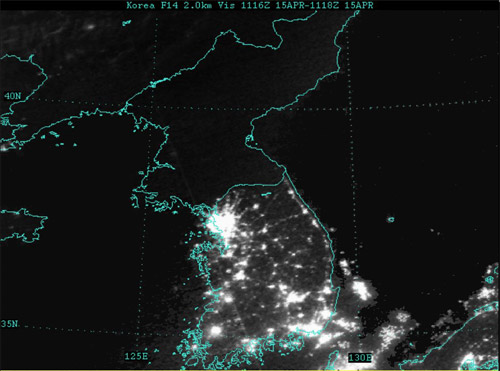
Shortages and North Korea isolation
This satellite view of the Korean Peninsula taken at night dramatically illustrates North Korea’s shortages and underdevelopment. These shortages and isolation did not prevent the North Korean regime from pursuing nuclear weapons, considered a guarantee of its safety and survival..
DR
The Democratic People’s Republic of Korea (DPRK) is a case of nuclear proliferation. The PRK was the only one of the three nations, classified as part of the axis of evil by US President George W. Bush in 2002, to have knowingly and publicly developed nuclear weapons. Not to use them, but to ensure the survival of its regime. North Korea itself was not threatened or involved in terrorism. It is located in a politically stable region, with a shared border with China, which was its long-time protector and its powerful neighbour, which possesses a large fleet of reactors.
Despite being a People’s Republic, the DRPK behaves like a curious pseudo-monarchy. Kim Il Sung, symbol and hero of the communist resistance during the Korean War (1950-52), was succeeded in 1993 by his son Kim Jong Il, a secretive and inconspicuous figure who served as a front for a military dictatorship. After his death in 2010, Kim Jong Il was succeeded by Kim Jong Un, then aged 30. This curious monarchy, cut off from the world, try to ensure its survival. Its 25 million inhabitants, half the size of its southern neighbour, have often been plunged into poverty and famines whose muffled echoes reach us.
Unlike Iran, whose leaders constantly repeat that their nuclear program is only civilian, North Korea has always stated its intention to acquire the atomic bomb. Their bomb race has gone through many vicissitudes, with alternating entries and exits from the Non-Proliferation Treaty. Thus, from 1994 to 1999, under the Clinton administration, the DRPK had committed to freeze its nuclear weapons program, in exchange for an offer of economic cooperation that included a contract to build two civilian reactors. But after its 2002 classification in the axis of evil, everything went wrong and bridges were burned. The IAEA (International Atomic Energy Agency) inspectors were expelled at the end of 2002, and North Korea reactivated its nuclear facilities, outside any control, with a view to achieving the bomb.
Four years later, on October 9, 2006, Pyongyang conducted its first nuclear test. The circumstances of the explosion and its power were poorly understood. The power of the explosion appeared to have been low, according to data collected in neighbouring countries. But after this symbolic entry into the « club » of nuclear-armed nations, North Korea became conciliatory and agreed to inspections of its facilities and their dismantling in exchange for economic aid.
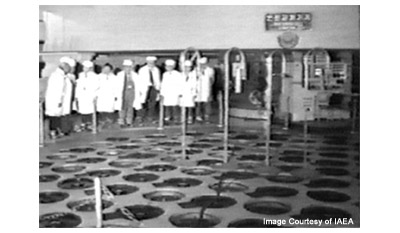
Yongbyon : a small reactor producing plutonium
This blurry photo from the 1990s shows inspectors and technicians standing over the core of a 5 MWe research reactor. Such a reactor, given enough time after the inspectors were expelled, was enough to produce a few kilograms of plutonium-239. On May 11, 2005, Pyongyang announced that it had extracted the plutonium needed for an underground test from 8,000 spent fuel rods at the Yongbyon reactor.
© DR/AIEA
It was China’s irritation and pressure from this great power, its powerful protector, perhaps more than sanctions, that led to the reversal that followed, with the return of the inspectors, the Americans visit to the facilities, and their planned dismantling. The crisis illustrates the importance of serious inspections to prevent nuclear proliferation. The experience of North Korea, which expelled IAEA inspectors, shows how a country without ressources, in the absence of oversight, managed to use a small reactor to produce the few kilograms of weapons-grade plutonium needed to build and detonate an atomic bomb.
2008 and 2009 were marked by a series of reversals. After dismantling some of its facilities and readmitting IAEA inspections, North Korea was on the verge of being removed from the list of countries « sponsoring » terrorism. But in September 2008, citing broken American promises, Pyongyang resumed plutonium processing. On May 25, 2009, North Korea conducted a second underground nuclear test.
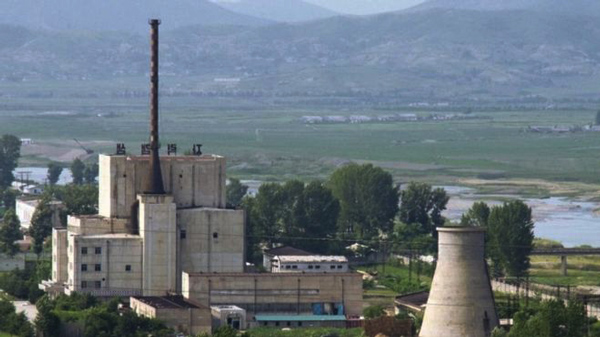
Yongbyon site : Production of plutonium
This photograph anterior to 2008 shows the Yongbyon site, which houses a reactor producing weapons-grade plutonium. The reactor was shut down in 2007 and the cooling tower demolished. But in 2015, Pyongyang announced that the facility had been restarted.
©BBC/Reuters
North Korea conducted its fourth nuclear weapons test in early 2016, followed by a fifth on September 9, 2016, the most powerful at this date. These tests and the missile tests that accompanied them violate sanctions imposed by the UN and major powers. The IAEA has no longer access to the facilities after being expelled from the country in 2009. Recent satellite photos indicate continued activities at the Yongbyon site, others related to reprocessing, and an expansion of enrichment facilities.
A brief honeymoon …
In September 2017, speaking at the UN, US President Donald Trump called his North Korean counterpart a rocket man, threatening to « totally destroy » North Korea. But a year later, a brief honeymoon occurred. Donald Trump and Kim Jong-un shook hands amicably in Singapore. Later, South and north Korea marched together in the opening ceremony of the 2018 Winter Olympics in Beijing.
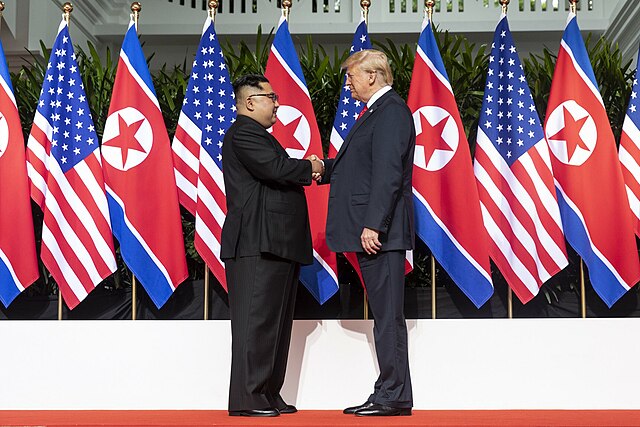
Red carpet and handshakes
Kim Jung-un and Donald Trump shaking hands during the Singapore summit on June 12, 2018. Meanwhile, the peaceful South Korean President Moon Jae-in met his North Korean counterpart several times. On April 27, 2018, at Pan-Mun-Jon, on the demarcation line, the two leaders took a symbolic step, one into North Korea, the other into South Korea.
@Shealah Craighead/photowhitehouse
The honeymoon ended after an unsuccessful meeting in Hanoi on February 27 and 28, 2019. South Korean and American military activities near the 37th parallel fueled tensions. After 2019, the confrontation restarted. Pyongyang developed missiles capable of delivering nuclear weapons, conducting several ballistic missile tests in the Sea of Japan. In 2022, North Korea tested a record number of missiles, some of which, like Hwasong-14 to 17, were said to be able of reaching the United States. In 2024, it revealed the existence of highly enriched uranium facilities, a component of nuclear weapons.
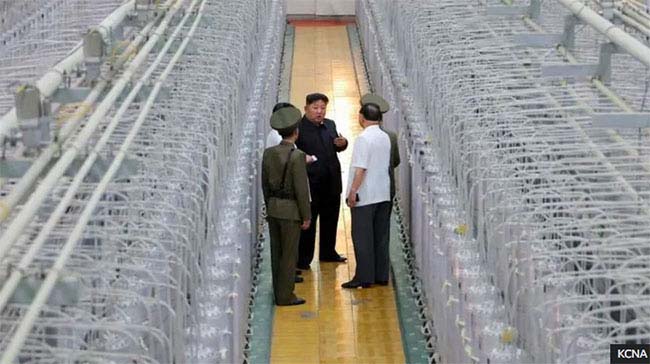
2024 : North Korea unveils its 90% uranium enrichment facilities
This photo, released on September 13, 2024, by North Korea’s official news agency, shows Kim Jong-un inspecting a uranium enrichment facility at an undisclosed location. The facility produces highly enriched uranium, needed to make nuclear bombs, using high-speed centrifuges.
© North Korean official news agency
The photographs of centrifuge facilities are reminiscent of those discussed for Iran in 2015-2016. Iran then had the know-how and skills to achieve the Bomb, but it did not do so. North Korea had fewer resources, but despite shortages and isolation, achieving an atomic weapon was for the North Korean regime a guarantee of its safety and a means of survival.
N Korea’s Yongbyon plutonium site likely reactivated says IAEA – BBC article: june,7 2016
North Korea: what missiles does it have? – BBC article: september,5 2023
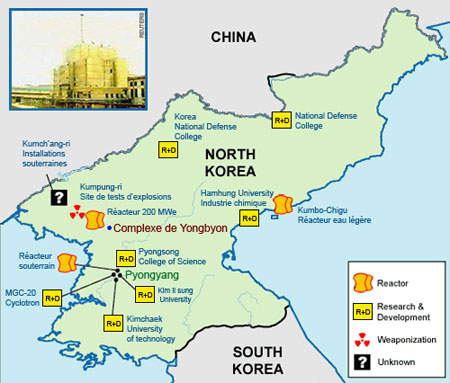
Map of North Korea nuclear installations
The inset shows an exterior view of the Yongbyon reactor where weapons-grade plutonium was reportedly produced.
© Center for Nonproliferation Studies, Monterey Institute of International Studies
See also :
Other articles on the subject « Nuclear Proliferation »
The uranium pathway
Centrifuging and enriching uranium 235 Taking the uranium pathway towards proliferation, the key [...]
The plutonium pathway
Extracting weapon-grade plutonium from spent fuel For the plutonium pathway, the key technology i[...]
Iranian Centrifuges
Technical Challenges: IR-1 and IR-2 Centrifuges Uranium enrichment requires significant technical[...]